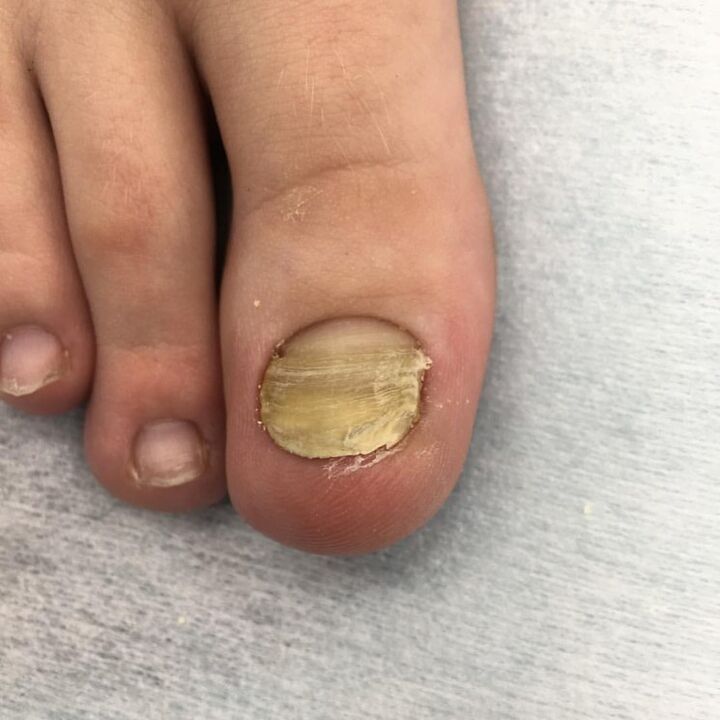Onychomycosis - nail damage with fungal infection. The disease occurs in 5-10% of the population and among other nail lesions is approximately 30%.
Causes of onychomycosis
Funny plate infections occur mainly in public baths, sauna, pool. Scale with pathogenic mushrooms, which fall into patients with onychomycosis, fall on the floor, benches, bars, routes, carpets and waste. In high humidity, mushrooms can not only last long, but also breed, especially on unpainted wood and gratings, which makes them a source of intense infection.

Often, onychomycosis is transmitted in the family when using general shoes, towels, wipes, inadequate bath processing after washing, and caused by carpets and gratings in the bathroom. Damage to the nails usually occurs when combing focus on the skin.
The occurrence of onychomycosis is facilitated by nail trauma, especially various (in athletes), blood supply to the limbs, severe joint disease (diabetes mellitus, immunodeficiency condition, blood disease).
Onychomycosis is often found in people who have long received antibacterial therapy, corticosteroids and immunosuppressive. The nail plate wound takes place second: initially, mushrooms affect the interdigital or single folds, and then the nails.
Three types of onychomycosis are distinguished worldwide:
- Normotorophical,
- Hypertrophic
- Atopic.
With a smooth type of scars onychomycosis, only the color of the nails changes: in the department, extreme spots and strips, different colors of white to care. Gradually, the entire nail changed the color, maintaining, however, shining and normal thickness.
With hypertropic types, color changes, nails are shining, becoming boring, thick and deformed, partially destroyed, especially from the side. Often the patient is in pain while walking. Typical nail fungus is characterized by a boring gray dye of the affected nail part, thinning and rejection of the box; The naked area is covered with loose layers.
We treat fungus
Local antifungal agents are ineffective with damage to the nail plate. Processing with antifungal ointments, creams, solutions, varnishes must be preceded by the removal of mechanically affected areas or using keratolytic plaster.
Mechanical removal consists of cutting or cutting with a bite of debris affected on the nail plate.
The use of keratolytic plaster in the treatment of onychomycosis allows you to soften your nails, as a result and painlessly be removed from the surface of the nail bed with a dull scissors or scissors.
As a keratolytic agent, drugs are used, including ointments containing 1% antifungal agents and 40% urea. The ointment is applied to the surface of the nail and covered with adhesive and attached bandages. After a day, the area affected by onychomycosis is cleaned. The procedure is performed daily until the affected nails are completely removed. In the future, when the affected nails are removed, the local is used: antifungal varnish.
- In the first month of treatment, the drug is prescribed for 6-8 tablets a day (750-1000 mg), at the same dose in the same dose daily, and then, until a healthy nail plate, 2 times a week. It is taken in 3 doses with one teaspoon of vegetable oil. The duration of treatment for brush mycosis is 4-6 months, with micosis of the foot-9-12, and also 18 months.
- Treatment with fungal preparation ensures healing in only 40% of patients. The combination of nail removal increases the percentage of healing. However, a large number of side effects, as well as a high percentage of the relapse of the disease, limit their use.

For successful and safe onychomycosis treatment, it is advisable to adhere to certain rules with systemic antifungal drugs.
First of all, the diagnosis should be believed. The drug cannot be prescribed if there is no laboratory confirmation.
After the diagnosis is made, it is necessary to collect the history of allergies carefully. If at the same time, medications or foods that cause allergic reactions or other intolerance manifestations are detected, then their intake should be excluded.
For the duration of treatment with systemic antimics, it is advisable to limit the use of other drugs, unless it is important.
Prevention and treatment
To prevent gastrointestinal disorders, it is recommended to exclude products that cause bloating from food during treatment: black bread, legumes, milk, cabbage.
Not important is the selection of comfortable shoes during treatment and after completion. Often, the increase in the condition of the nails is clearly correlated by wearing non -traumatic shoes, as the pollination caused by the shoe can cause severity or distal to the onychomycosis nails. Before starting treatment, it is advisable to conduct a general and biochemical blood test indicator study.
The control exam must be conducted for the first time after 2 weeks, then 1 month. Microscopy control - 6 months after the end of treatment. The identification of mycelium fungal pathogens serves as a guide for the second treatment of treatment with early nail surgery.
Prognosis for the treatment of onychomycosis
Despite the high percentage of antidote for patients with onychomycosis when using therapeutic agents, therapy with these drugs does not exclude the use of local antifungal drugs. A combination of removal of conservative nail plate and surgery reduces the time to take systemic anti -bacterial agents and improve the effectiveness of treatment.























